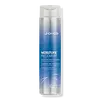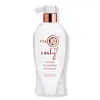What's inside
What's inside
 Key Ingredients
Key Ingredients

 Benefits
Benefits

 Concerns
Concerns

 Ingredients Side-by-side
Ingredients Side-by-side

Water
Skin ConditioningSodium Laureth Sulfate
CleansingCocamidopropyl Betaine
CleansingDipropylene Glycol
HumectantGlycol Distearate
EmollientSodium Methyl Cocoyl Taurate
CleansingCocamide Mea
EmulsifyingSorbitol
HumectantPentapeptide-29 Cysteinamide
Pentapeptide-30 Cysteinamide
Tetrapeptide-28 Argininamide
Tetrapeptide-29 Argininamide
Hydrolyzed Keratin
HumectantCocodimonium Hydroxypropyl Hydrolyzed Keratin
Skin ConditioningSimmondsia Chinensis Seed Oil
EmollientHydrolyzed Algin
Sea Water
HumectantChlorella Vulgaris Extract
Skin ConditioningSodium Cocoamphoacetate
CleansingSilicone Quaternium-16
Skin ConditioningCitric Acid
BufferingGuar Hydroxypropyltrimonium Chloride
Skin ConditioningDisodium EDTA
Undeceth-11
EmollientArginine
MaskingSodium Citrate
BufferingButyloctanol
HumectantUndeceth-5
EmulsifyingPEG-150 Pentaerythrityl Tetrastearate
EmulsifyingPEG-6 Caprylic/Capric Glycerides
EmulsifyingStearyl Dihydroxypropyldimonium Oligosaccharides
Propylene Glycol
HumectantDMDM Hydantoin
PreservativeMethylparaben
PreservativeSodium Chloride
MaskingSodium Hydroxide
BufferingBenzyl Benzoate
AntimicrobialLimonene
PerfumingParfum
MaskingCI 60730
Cosmetic ColorantCI 42090
Cosmetic ColorantCI 19140
Cosmetic ColorantWater, Sodium Laureth Sulfate, Cocamidopropyl Betaine, Dipropylene Glycol, Glycol Distearate, Sodium Methyl Cocoyl Taurate, Cocamide Mea, Sorbitol, Pentapeptide-29 Cysteinamide, Pentapeptide-30 Cysteinamide, Tetrapeptide-28 Argininamide, Tetrapeptide-29 Argininamide, Hydrolyzed Keratin, Cocodimonium Hydroxypropyl Hydrolyzed Keratin, Simmondsia Chinensis Seed Oil, Hydrolyzed Algin, Sea Water, Chlorella Vulgaris Extract, Sodium Cocoamphoacetate, Silicone Quaternium-16, Citric Acid, Guar Hydroxypropyltrimonium Chloride, Disodium EDTA, Undeceth-11, Arginine, Sodium Citrate, Butyloctanol, Undeceth-5, PEG-150 Pentaerythrityl Tetrastearate, PEG-6 Caprylic/Capric Glycerides, Stearyl Dihydroxypropyldimonium Oligosaccharides, Propylene Glycol, DMDM Hydantoin, Methylparaben, Sodium Chloride, Sodium Hydroxide, Benzyl Benzoate, Limonene, Parfum, CI 60730, CI 42090, CI 19140
Water
Skin ConditioningSodium Cocoyl Isethionate
CleansingSodium Lauryl Sulfoacetate
CleansingDisodium Laureth Sulfosuccinate
CleansingCocamide Mea
EmulsifyingCocamidopropyl Betaine
CleansingGlycerin
HumectantDecyl Glucoside
CleansingParfum
MaskingPolyquaternium-73
Hydrolyzed Rice Protein
Skin ConditioningPersea Gratissima Oil
Skin ConditioningGardenia Taitensis Flower Extract
Skin ConditioningSqualane
EmollientTheobroma Cacao Seed Butter
EmollientPisum Sativum Peptide
Skin ConditioningCocos Nucifera Oil
MaskingEthylhexyl Olivate
Skin ConditioningPanthenol
Skin ConditioningAcrylates Copolymer
Glycol Distearate
EmollientGuar Hydroxypropyltrimonium Chloride
Skin ConditioningAmodimethicone
Dihydroxypropyl PEG-5 Linoleammonium Chloride
C11-15 Pareth-7
EmulsifyingLaureth-9
EmulsifyingTrideceth-12
EmulsifyingButyrospermum Parkii Butter
Skin ConditioningGlycereth-26
HumectantLauryl Alcohol
EmollientCinnamidopropyltrimonium Chloride
Methylchloroisothiazolinone
PreservativeMethylisothiazolinone
PreservativeSodium Hydroxide
BufferingCitric Acid
BufferingWater, Sodium Cocoyl Isethionate, Sodium Lauryl Sulfoacetate, Disodium Laureth Sulfosuccinate, Cocamide Mea, Cocamidopropyl Betaine, Glycerin, Decyl Glucoside, Parfum, Polyquaternium-73, Hydrolyzed Rice Protein, Persea Gratissima Oil, Gardenia Taitensis Flower Extract, Squalane, Theobroma Cacao Seed Butter, Pisum Sativum Peptide, Cocos Nucifera Oil, Ethylhexyl Olivate, Panthenol, Acrylates Copolymer, Glycol Distearate, Guar Hydroxypropyltrimonium Chloride, Amodimethicone, Dihydroxypropyl PEG-5 Linoleammonium Chloride, C11-15 Pareth-7, Laureth-9, Trideceth-12, Butyrospermum Parkii Butter, Glycereth-26, Lauryl Alcohol, Cinnamidopropyltrimonium Chloride, Methylchloroisothiazolinone, Methylisothiazolinone, Sodium Hydroxide, Citric Acid
Ingredients Explained
These ingredients are found in both products.
Ingredients higher up in an ingredient list are typically present in a larger amount.
Citric Acid is an alpha hydroxy acid (AHA) naturally found in citrus fruits like oranges, lemons, and limes.
Like other AHAs, citric acid can exfoliate skin by breaking down the bonds that hold dead skin cells together. This helps reveal smoother and brighter skin underneath.
However, this exfoliating effect only happens at high concentrations (20%) which can be hard to find in cosmetic products.
Due to this, citric acid is usually included in small amounts as a pH adjuster. This helps keep products slightly more acidic and compatible with skin's natural pH.
In skincare formulas, citric acid can:
While it can provide some skin benefits, research shows lactic acid and glycolic acid are generally more effective and less irritating exfoliants.
Most citric acid used in skincare today is made by fermenting sugars (usually from molasses). This synthetic version is identical to the natural citrus form but easier to stabilize and use in formulations.
Read more about some other popular AHA's here:
Learn more about Citric AcidWe don't have a description for Cocamide Mea yet.
Cocamidopropyl Betaine is a fatty acid created by mixing similar compounds in coconut oil and dimethylaminopropylamine, a compound with two amino groups.
This ingredient is a surfactant and cleanser. It helps gather the dirt, pollutants, and other impurities in your skin to be washed away. It also helps thicken a product and make the texture more creamy.
Being created from coconut oil means Cocamidopropyl Betaine is hydrating for the skin.
While Cocamidopropyl Betaine was believed to be an allergen, a study from 2012 disproved this. It found two compounds in unpure Cocamidopropyl Betaine to be the irritants: aminoamide and 3-dimethylaminopropylamine. High-grade and pure Cocamidopropyl Betaine did not induce allergic reactions during this study.
Learn more about Cocamidopropyl BetaineGlycol Distearate serves as a pearlizing or opacifying agent in cosmetic products.
It's often included in cleansers and haircare products to give them a lustrous or shimmering appearance.
It is derived from stearic acid, a natural fatty acid commonly found in vegetable oils and animal fats.
Glycol Distearate isn't fungal acne safe.
Learn more about Glycol DistearateThis ingredient is derived from guar gum.
It is a conditioning ingredient, meaning it helps soften skin and hair.
Parfum is a catch-all term for an ingredient or more that is used to give a scent to products.
Also called "fragrance", this ingredient can be a blend of hundreds of chemicals or plant oils. This means every product with "fragrance" or "parfum" in the ingredients list is a different mixture.
For instance, Habanolide is a proprietary trade name for a specific aroma chemical. When used as a fragrance ingredient in cosmetics, most aroma chemicals fall under the broad labeling category of “FRAGRANCE” or “PARFUM” according to EU and US regulations.
The term 'parfum' or 'fragrance' is not regulated in many countries. In many cases, it is up to the brand to define this term.
For instance, many brands choose to label themselves as "fragrance-free" because they are not using synthetic fragrances. However, their products may still contain ingredients such as essential oils that are considered a fragrance by INCI standards.
One example is Calendula flower extract. Calendula is an essential oil that still imparts a scent or 'fragrance'.
Depending on the blend, the ingredients in the mixture can cause allergies and sensitivities on the skin. Some ingredients that are known EU allergens include linalool and citronellol.
Parfum can also be used to mask or cover an unpleasant scent.
The bottom line is: not all fragrances/parfum/ingredients are created equally. If you are worried about fragrances, we recommend taking a closer look at an ingredient. And of course, we always recommend speaking with a professional.
Learn more about ParfumSodium Hydroxide is also known as lye or caustic soda. It is used to adjust the pH of products; many ingredients require a specific pH to be effective.
In small amounts, sodium hydroxide is considered safe to use. However, large amounts may cause chemical burns due to its high alkaline.
Your skin has a natural pH and acid mantle. This acid mantle helps prevent harmful bacteria from breaking through. The acid mantle also helps keep your skin hydrated.
"Alkaline" refers to a high pH level. A low pH level would be considered acidic.
Learn more about Sodium HydroxideWater. It's the most common cosmetic ingredient of all. You'll usually see it at the top of ingredient lists, meaning that it makes up the largest part of the product.
So why is it so popular? Water most often acts as a solvent - this means that it helps dissolve other ingredients into the formulation.
You'll also recognize water as that liquid we all need to stay alive. If you see this, drink a glass of water. Stay hydrated!
Learn more about Water